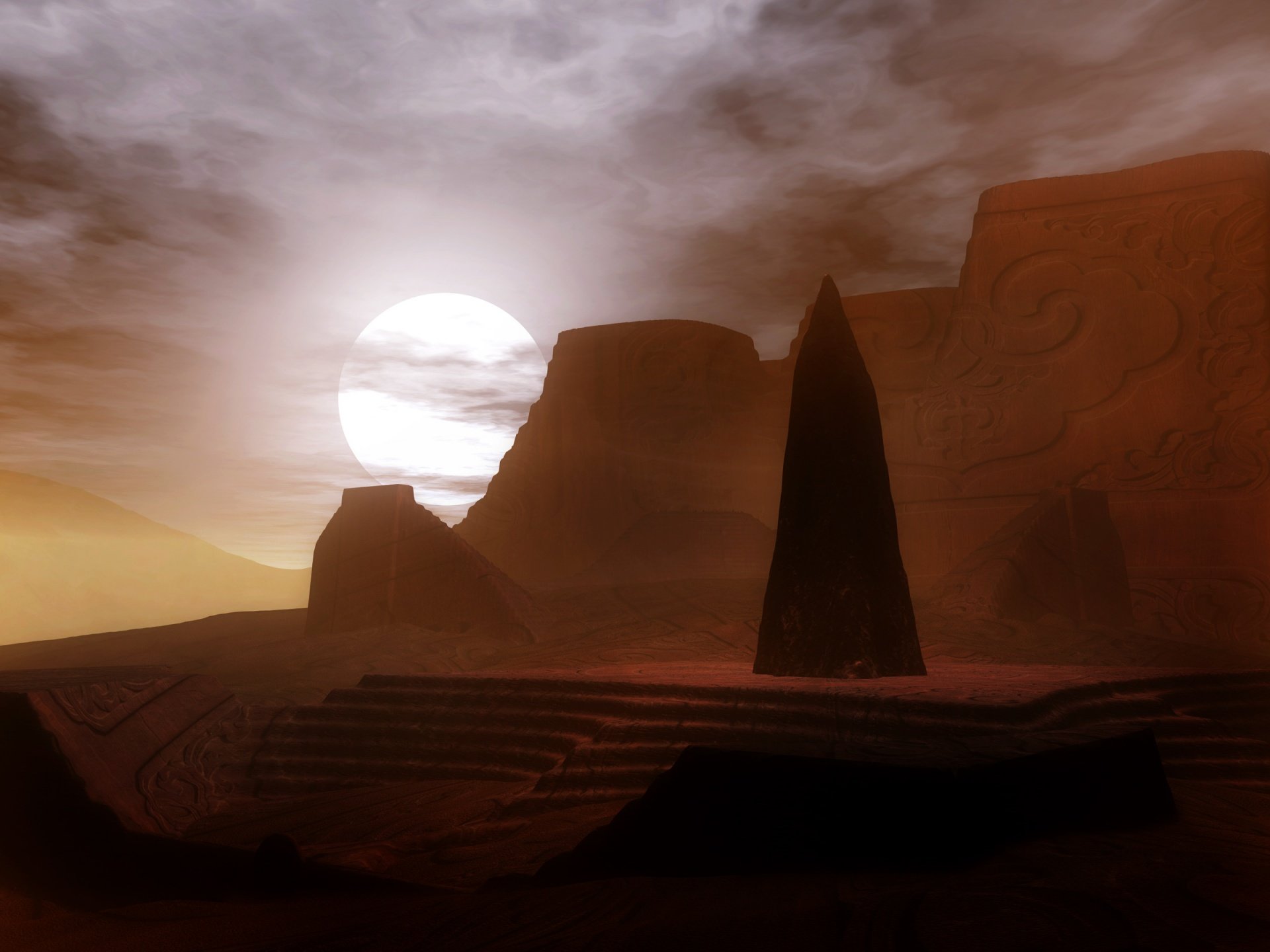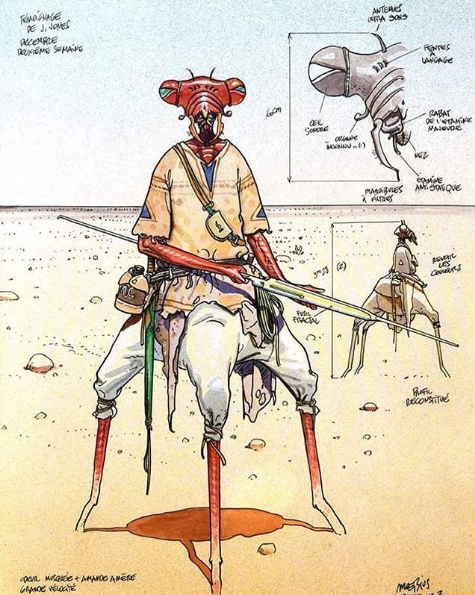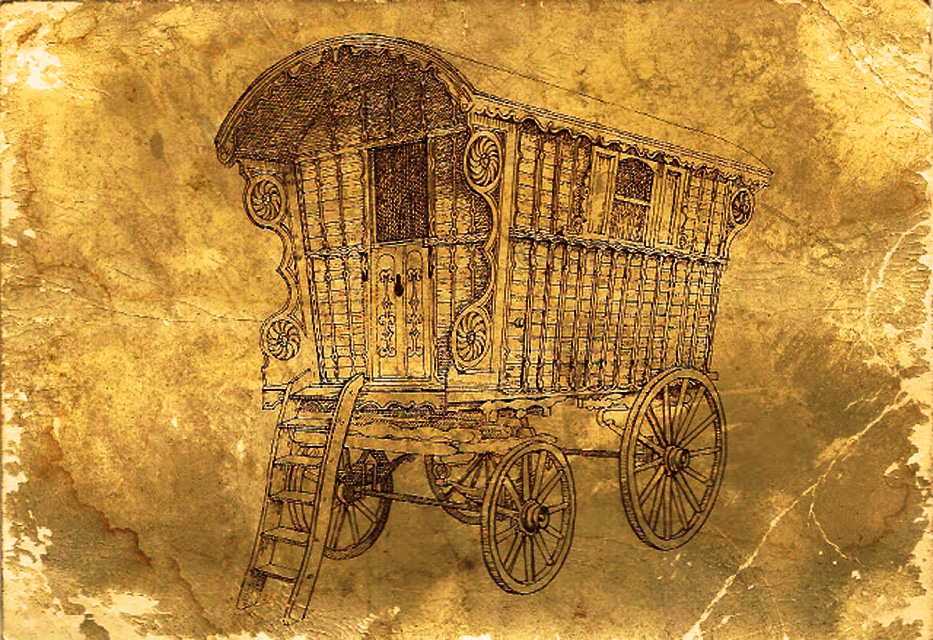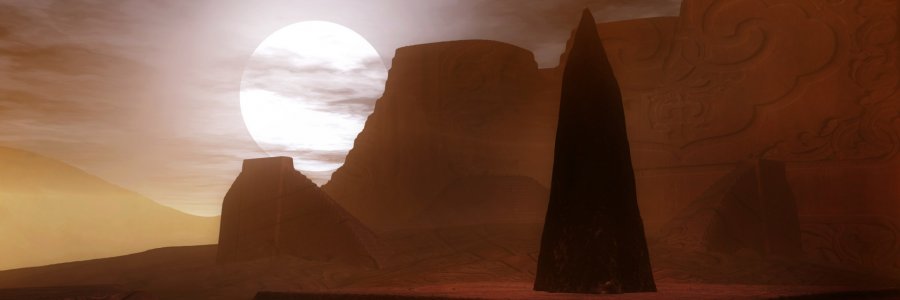This is a mini-setting made up of several factions, desert-themed monsters, Dyson Logos maps, random desert encounters, and a Big Score everyone's trying to get.
This article describes the factions and Big Score involved in this mini-setting; the next article will describe several different locations and a random encounter table. There's absolutely no order to the locations and encounters; you can mix and match them at will, and insert your own encounters.
Concept
Old Rabat seers have long predicted the return of Velile, an ancient sorcerer-king. Sure enough, last month an adventuring party entered the city of Thule with a huge red gem: one of Velile's Six Eyes.
Now the hunt is on for the other five. According to Rabat prophecy, they will be scattered in ruins across the Long Desert.
The PCs will likely be employed by the Guild of Hunters, but first, let's talk about the natives.

Factions
The Rabat
The Rabat are the natives of the Long Desert, living in small tribes that move from oasis to well and from well to oasis. They know the desert better than anyone else, and have long since given over hunting rights to the Guild of Hunters, and passage rights to the sturdy caravans of the Merchant's Alliance. Both these agreements provide valuable money that keeps the tribes' members from starving during lean years.
Similarly, the Rabat do not trouble adventurers who delve into the half-buried pyramid cities of the old Rabat empire. Those ruins no longer concern them. However, that might change now that the Eyes of Velile have appeared.
The Rabat organize into tribes headed by a chief. Zodawa, the chief of a large tribe, has been trying to claim the title of Kwelakwe, or Chief of Chiefs, but the tribes have not yet agreed on a stance yet. This might change with the appearance of the Eyes.
The tripedal Rabat adapt quickly to changing trends, their hard carapaces protecting them from errant sand and dust. They dress in relatively drab clothes, partly for decoration and partly for further protection from sandstorms and other harsh weather.
Their preferred weapon is their ubiquitous electro-spear, which they use both as cattle prod and weapon of war. It even holds a religious significance; when a rabat dies and is buried, its spear is broken, then driven into the ground as a grave marker.

Read more about the Rabat, which are based on the gorgeous above art piece by Jean "Moebius" Giraud.
The Guild of Hunters
Many creatures wander the desert and especially the tundra that border it. The Guild of Hunters sends parties in to hunt them carefully, butcher them responsibly, and bring the spoils back to the trade cities.
The Guild holds an interesting position of power. While the caravans trundle through the safest paths through the desert and the Rabat keep to their traditional routes, Guild hunting parties range around the desert, often exploring areas that even the Rabat avoid. As a result, Guild members are held in high regard by both Rabat and Alliance caravans, though they can't necessarily rely on them, either.
The Guild has its own agenda. It often accepts lucrative deals to recover lost artifacts, so hunters often receive abrupt special orders to head to a particular spot and, while hunting, find and bring back some object to the nearest Guild outpost.
Hunters come from a wide range of backgrounds, races, and specialties.
The Merchant's Alliance

The Merchant's Alliance presents itself as a mighty, united confederation of trade caravans, all traveling on the same tightly coordinated schedules and carefully protected by well-paid armed guards. Get a few drinks into a merchant and you may hear a different story. Some three hundred individual merchants make up the Alliance, each with their own expertise, trade specialties, supplies, and equipment. Their membership allows them to co-ordinate trips, cutting down on the costs of guards and rental space at each stop, but each merchant runs their business independently.
As a result, there's a not insignificant amount of competition and dissension within the ranks of the Alliance (though merchants are careful to keep this private, to preserve the Alliance's image). Each merchant tries to extract as much as possible out of their membership, straining its resources and the concordance that allows it to function.
The Alliance employs a very small number of people; a small staff of 3-5 officers at an office in each region in which it operates, plus a larger staff at its headquarters. Officers primarily coordinate caravan schedules and collect and distribute trade information, like supplies needed and available in the region. They're easily distinguished by their yellow sash, the one clear mark of an Alliance officer.
The Snake Folk
At least one party of snake folk prowl the Long Desert in search of ancient artifacts for their own mysterious ends. They are highly organized, each party containing researchers, fighters, hunters, and scouts.
The only reason snake folk ever venture out of their remote underground cities is to find and recover ancient artifacts, and the Long Desert is littered with them. Hunters have sighted snake folk parties deep in the desert for years, but their activity has increased in the months leading up to the recovery of the first Eye of Velile.
Snake folk are cruel and alien. They will single-mindedly slaughter anyone who discovers them, though they'll also abruptly run from a fight once they calculate they're unlikely to win. In the latter case, they will dog their enemy and attempt to kill through stealth before that enemy returns to civilization (particularly with surprise attacks at night).
The snake folk may have already recovered one Eye, in which case it would be in (relative) safekeeping at the Fortress of Fire, detailed in the next article.

![[Atom feed]](/user/themes/geek-archaeology/images/atom-feed.png)
![[RSS feed]](/user/themes/geek-archaeology/images/rss-feed.png)
![[iTunes podcast feed]](/user/themes/geek-archaeology/images/itunes-feed.png)